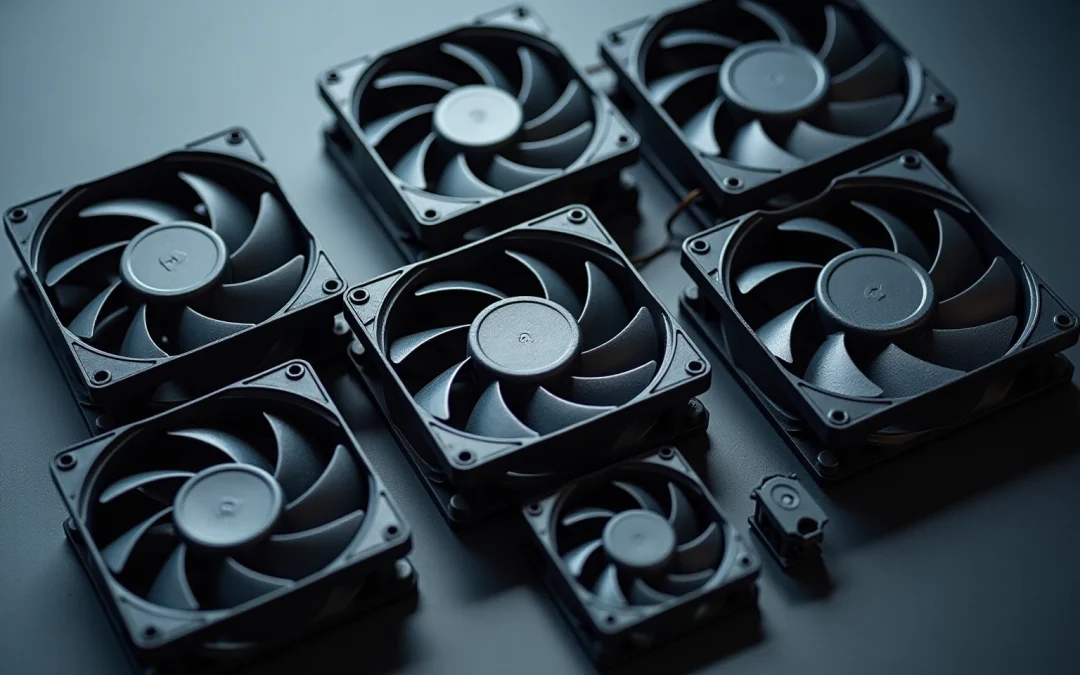Overview
The article explores various computer case fan sizes, underscoring their specific applications and advantages for achieving optimal cooling solutions in PC builds. It asserts that the selection of the appropriate fan size—such as 120mm for standard builds or 200mm for high-performance systems—is vital for effective temperature management. This selection must also balance airflow and noise levels. Supported by real-world examples and market trends, the article provides a comprehensive overview that guides readers toward making informed decisions.
Introduction
The realm of computer cooling is both vast and intricate, where the size of a fan plays a pivotal role in determining performance and efficiency. With a multitude of options available, grasping the specific benefits and applications of various computer case fan sizes is essential for achieving optimal thermal management within any setup.
How does one navigate the extensive array of choices to ensure their system remains cool and quiet? This article explores the ten most common computer case fan sizes, examining their unique advantages and empowering users to make informed decisions for their builds.
Gagner-Toomey Associates: Leading Solutions for Computer Cooling
Gagner-Toomey Associates stands at the forefront of advanced thermal solutions specifically designed for the electronics industry. By emphasizing performance and efficiency, the company showcases a diverse range of manufacturers that specialize in temperature control technologies. Their unwavering commitment to excellence guarantees that engineers have access to top-tier products essential for maintaining optimal temperatures in electronic systems.
By equipping engineers with innovative solutions in temperature regulation, power management, and interconnect technologies, Gagner-Toomey Associates solidifies its position as a key player in the market for computer enclosures and other temperature control solutions.
120mm Fans: The Standard for Most PC Cases
The industry standard for most PC cases is the 120mm computer case fan sizes, which provide an optimal balance of airflow and noise levels. These devices typically deliver adequate cooling for a range of components while operating with minimal sound. With a diameter of 120mm, this size among computer case fan sizes seamlessly fits into most mid-tower and full-tower cases, demonstrating its adaptability across various builds. Their widespread popularity is further bolstered by the extensive selection of models available, which cater to performance, aesthetics, and noise reduction preferences. This versatility not only meets the diverse needs of users but also enhances overall system efficiency.
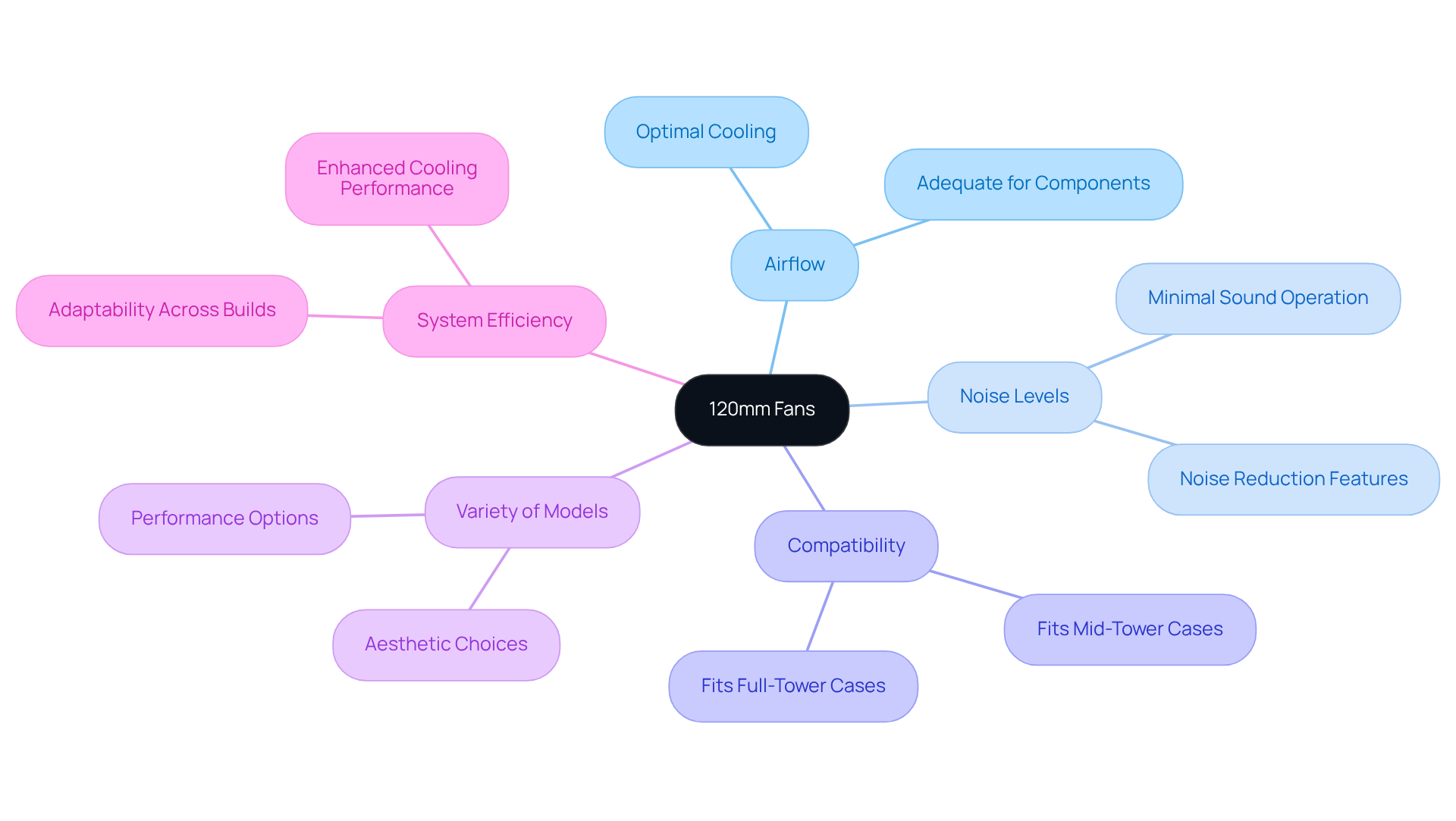
140mm Fans: Enhanced Airflow with Reduced Noise
140mm cooling units are increasingly favored by PC builders who prioritize enhanced airflow while minimizing noise. These units are capable of moving a greater volume of air at lower RPMs compared to their 120mm counterparts, leading to quieter operation. This characteristic makes them ideal for high-performance systems where effective temperature management is crucial, yet noise levels must be kept to a minimum. Additionally, numerous cases are designed to accommodate different computer case fan sizes, specifically 120mm and 140mm cooling units, allowing users to choose based on their specific thermal requirements.
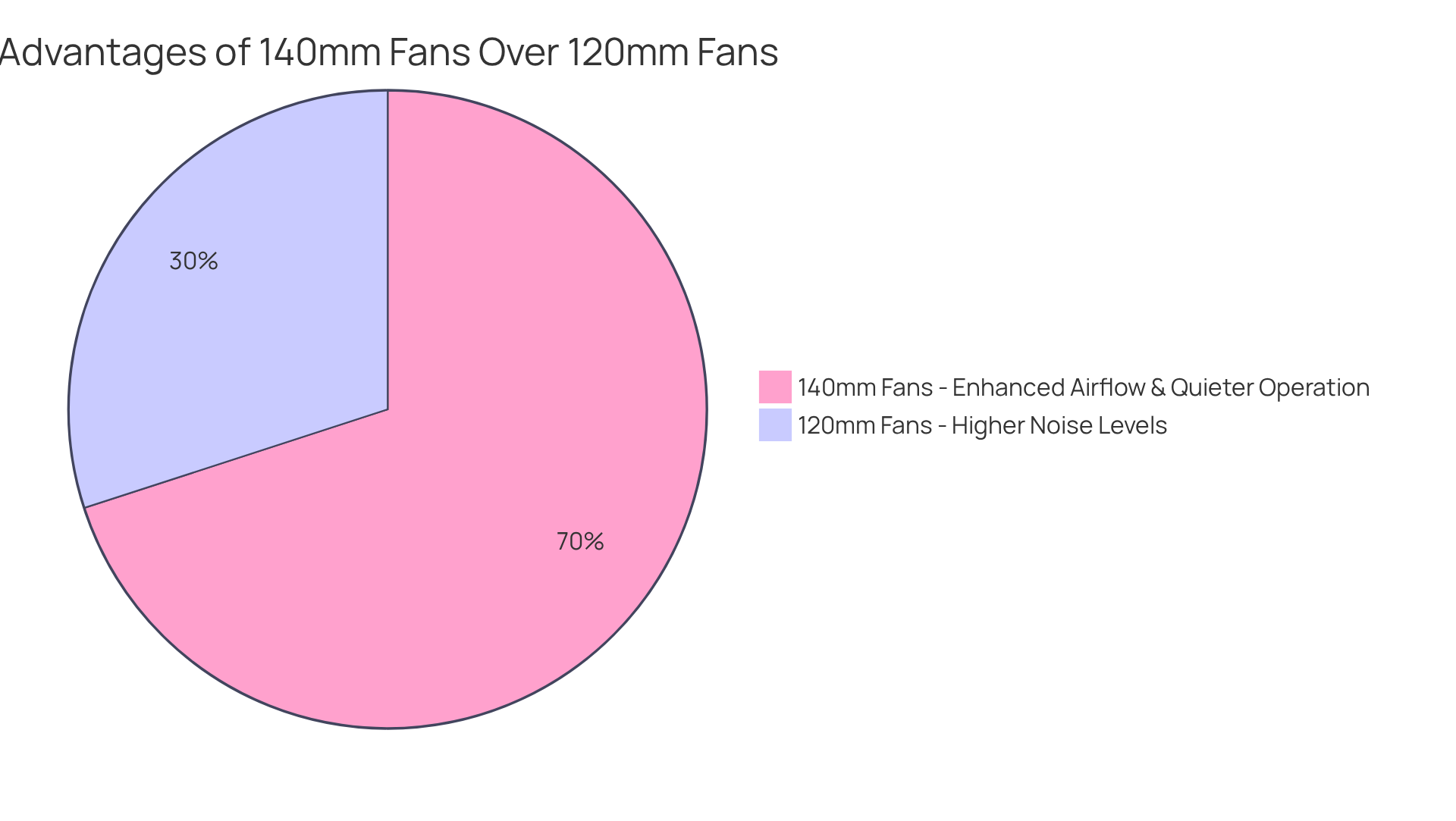
80mm Fans: Compact Solutions for Small Form Factor Cases
80mm coolers are specifically engineered for small form factor cases, where maximizing space is essential. Although they may not match the power of larger devices, their role in maintaining airflow within compact structures is crucial. These devices are often employed in older systems or specialized applications where larger options are impractical. Despite their smaller dimensions, 80mm units can effectively cool low to mid-range components, making them an excellent option for budget builds or compact setups.
In recent trends, the demand for smaller computer case fan sizes, especially 80mm cooling devices, has surged as more users seek efficient cooling solutions for smaller systems. Engineers have observed that these devices can greatly improve ventilation in confined areas, ensuring optimal performance without sacrificing noise levels. As one engineer noted, ‘In compact constructions, every degree matters; 80mm units deliver the required airflow while fitting seamlessly into restricted areas.’
Additionally, the PC Case Fans Market, valued at USD 14.37 Billion in 2023, is expected to attain USD 20.44 Billion by 2031, indicating an increasing interest in innovative temperature regulation solutions designed for compact environments. This trend is driven by the growing popularity of gaming and e-sports activities, where efficient thermal management is crucial. As the market evolves, computer case fan sizes, particularly 80mm units, will continue to play a vital role in providing sufficient thermal management solutions for compact builds, catering specifically to the needs of gamers and overclocking enthusiasts.

200mm Fans: Maximum Airflow for Large Cases
200mm blowers are engineered for larger cases, delivering impressive airflow while operating at lower RPMs, which results in quieter performance. This makes them particularly well-suited for high-end gaming rigs and workstations that require efficient cooling solutions. Their substantial size allows for fewer units to be installed, simplifying the setup process and minimizing potential noise. For example, the AeroCool Silent Master achieves an airflow rate of 76 CFM at an astonishingly low 18 dBA and operates at 800 RPM, exemplifying the effectiveness of larger units in sustaining a quiet environment.
The burgeoning PC Case Fans Market, valued at USD 14.37 Billion in 2023 and projected to reach USD 20.44 Billion by 2031, underscores the rising demand for efficient cooling solutions. Furthermore, the CORSAIR FRAME 5000D can accommodate two 200mm cooling units in the front, demonstrating practical applications and compatibility considerations. However, it is crucial to verify compatibility with specific cases regarding computer case fan sizes, as not all designs can support these larger units.
Advancements in 200mm fan technology continue to enhance their performance, making them a preferred choice for enthusiasts seeking optimal temperature management without compromising noise levels.
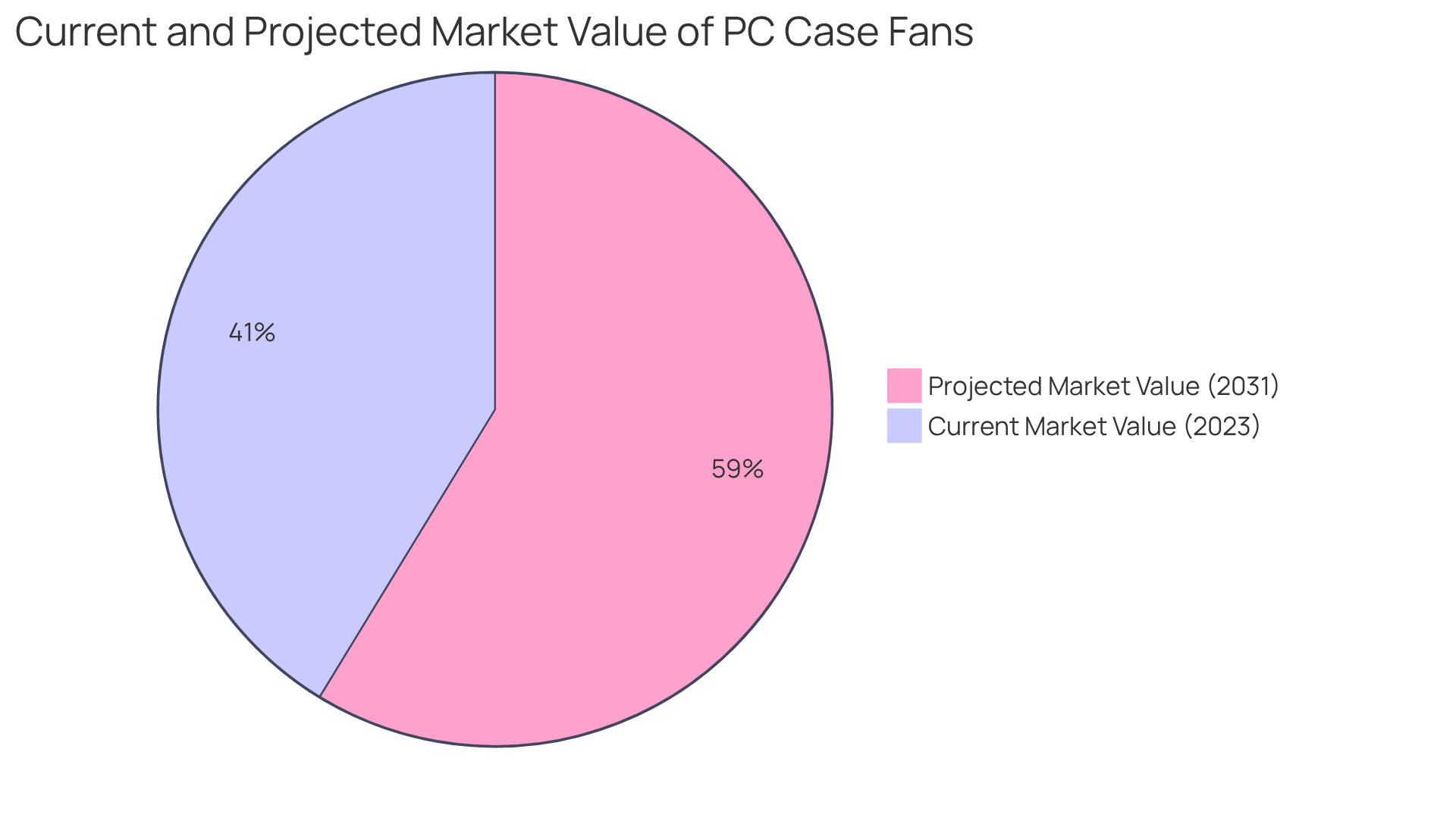
92mm Fans: Versatile Options for Diverse Builds
92mm cooling units represent a versatile solution for builders seeking an optimal balance between size and airflow. These units are frequently deployed in scenarios where larger devices cannot be accommodated yet efficient temperature regulation remains essential. Particularly advantageous in compact constructions, they also serve as additional cooling for critical components such as GPUs or CPUs. Although less common than their 120mm or 140mm counterparts, 92mm models are one of the computer case fan sizes that provide a suitable option for distinctive configurations, catering to specific cooling needs.
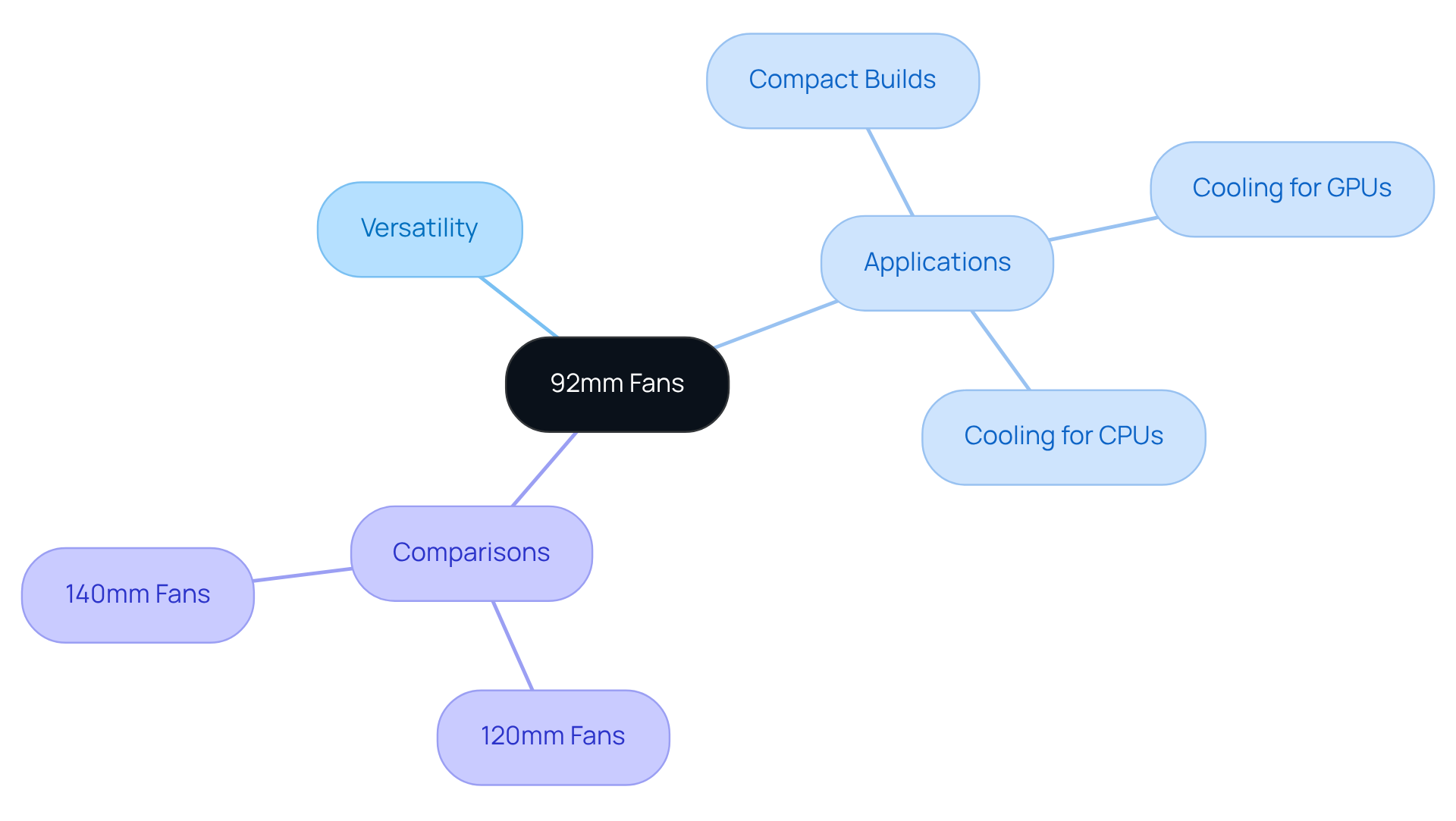
60mm Fans: Specialized Cooling for Unique Applications
60mm cooling units play a pivotal role in specialized applications, including:
- 3D printers
- NAS devices
- Compact electronics
Their compact dimensions allow them to fit into narrow spaces where larger units are impractical. However, these units often require higher RPMs to produce adequate airflow. While they may not be suitable for general PC temperature regulation, their importance cannot be overstated for devices that demand efficient thermal management in confined areas. Understanding their unique capabilities is essential for optimizing performance in these specialized environments.
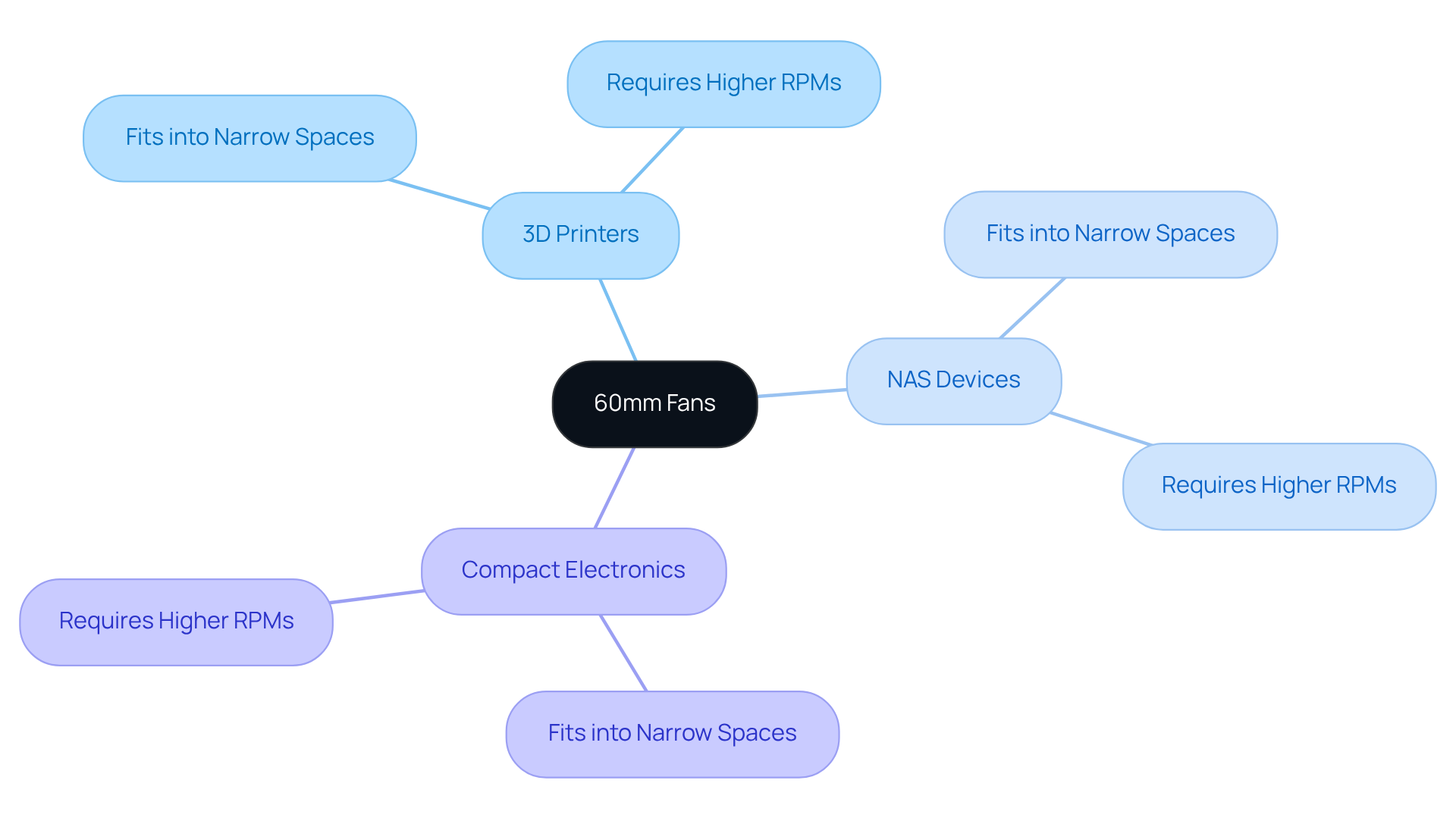
30mm Fans: Ultra-Compact Solutions for Space-Constrained Builds
30mm devices represent ultra-compact thermal management solutions specifically designed for the most space-restricted applications. These devices are frequently utilized in routers, small form factor PCs, and embedded systems. While they can provide adequate ventilation, their compact dimensions typically necessitate higher RPMs, which may lead to increased noise levels. Users must carefully consider the trade-off between size and thermal efficiency when selecting these devices for their setups.
With the compact ventilation market projected to grow at a CAGR of 6.48% from 2025 to 2033, the demand for innovative temperature regulation solutions, such as 30mm devices, is anticipated to rise. Engineers are increasingly acknowledging the importance of balancing dimensions with performance, as underscored by industry insights that highlight the critical need for effective temperature management in limited spaces.
The compact device market, estimated at approximately USD 15.7 billion in 2024, reflects a growing trend towards energy-efficient and portable temperature control solutions, positioning 30mm units as a relevant choice for contemporary applications.

150mm Fans: Unique Options for Specialized Cases
150mm units occupy a distinctive position in the realm of computer temperature management, striking a balance between the more prevalent sizes. These devices are particularly advantageous in specific scenarios tailored to their capabilities, providing an optimal combination of airflow and noise reduction. Their unique dimensions render them ideal for custom builds that necessitate specialized temperature management solutions, especially in contexts where space and performance are paramount.
While they may not be as widely available as their 120mm or 140mm counterparts, 150mm models are increasingly recognized for their efficacy in enhancing thermal management. Industry specialists emphasize that the correct computer case fan sizes can significantly influence system performance, with numerous users reporting improved air circulation efficiency and quieter operation in their setups.
As trends in 2025 indicate a growing interest in unique fan dimensions, 150mm fans are emerging as a preferred choice for enthusiasts aiming to elevate their builds.
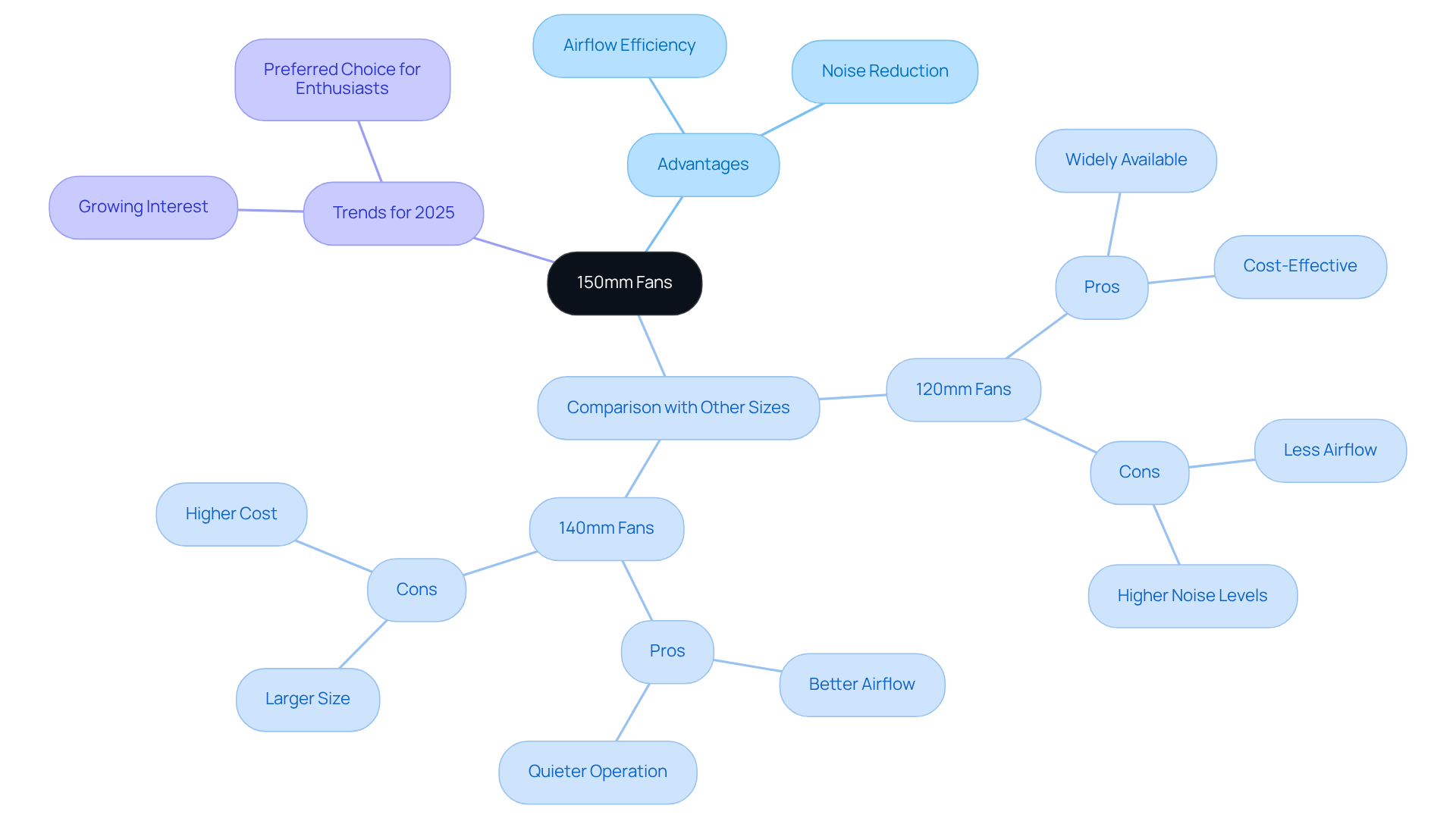
Choosing the Right Fan Size: Key to Optimal Cooling Performance
Selecting the appropriate computer case fan sizes is essential for achieving optimal temperature management in any PC assembly. Key factors to consider include the computer case fan sizes, the case dimensions, the components requiring temperature regulation, and the desired equilibrium between ventilation and noise levels. Larger computer case fan sizes, like 120mm and 140mm, typically provide superior ventilation at lower RPMs, resulting in quieter operation. For instance, computer case fan sizes such as 120mm fans are the preferred choice for standard builds, offering a harmonious blend of size, airflow, and noise control, whereas 140mm variants excel in mid-tower and full-tower cases, delivering enhanced cooling efficiency.
Conversely, smaller computer case fan sizes such as 80mm and 92mm are often necessary for compact builds, though they may struggle with ventilation efficiency and can generate more noise due to higher RPMs. Research indicates that while 80mm fans are cost-effective and widely available, they are less efficient in circulation compared to their larger counterparts. A case study from Bess Labs underscores that fan size alone does not guarantee performance; it is crucial to evaluate air movement requirements and fan efficiency to maintain optimal ventilation.
Real-world examples illustrate the significance of fan size on cooling performance. For example, the Cooler Master SickleFlow 120 V2 fan is engineered for efficiency, enhancing airflow and static pressure, making it suitable for various applications. In contrast, 200mm fans, commonly found in high-end gaming cases, provide substantial airflow capacity while operating at minimal noise levels, although they may have compatibility limitations with certain cases.
Ultimately, understanding the specific cooling requirements of your system will help you choose the most effective computer case fan sizes for your setup, ensuring that your PC operates efficiently and quietly.
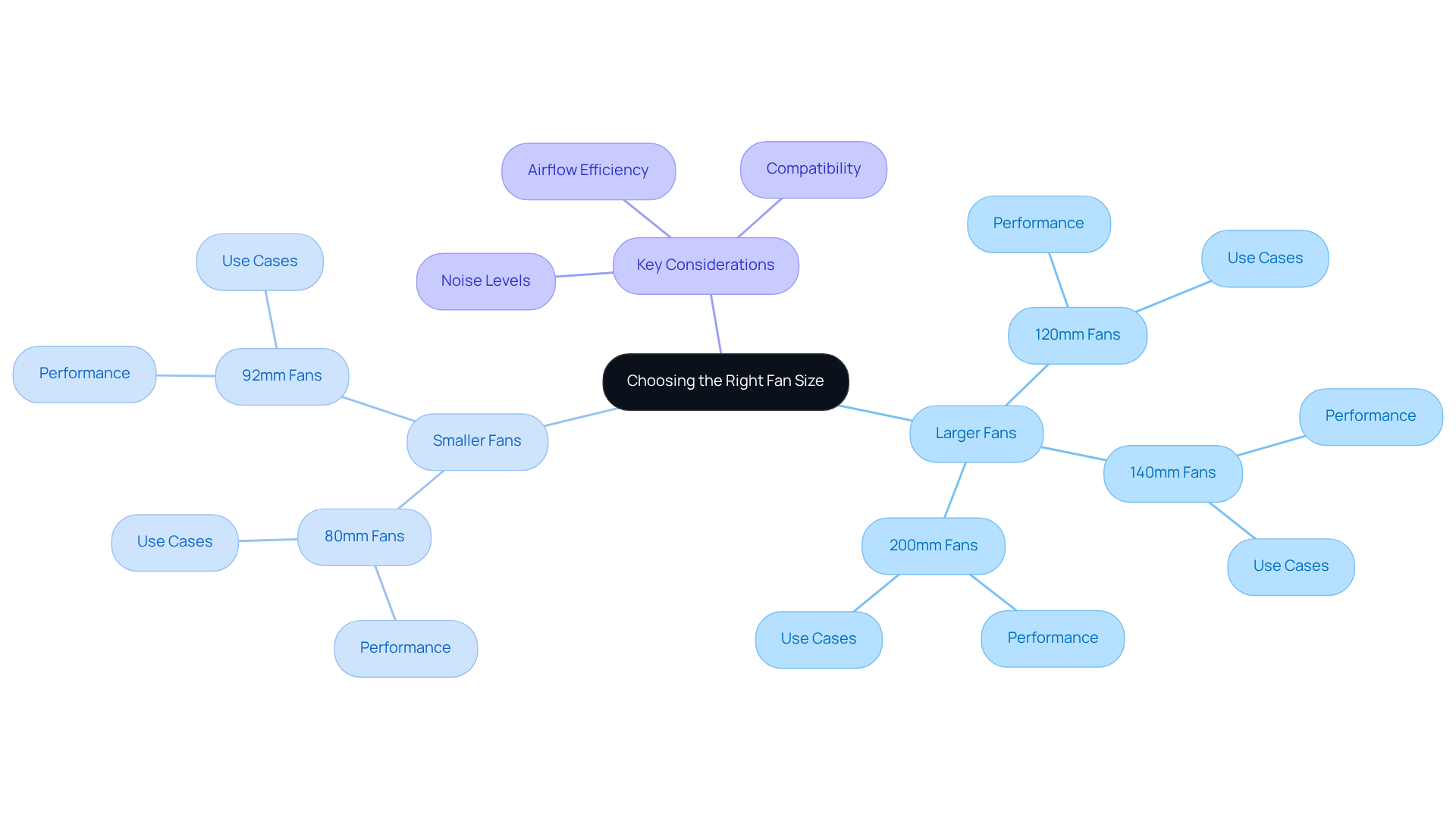
Conclusion
Selecting the appropriate computer case fan size is essential for achieving optimal cooling performance in any PC setup. This article elucidates various fan sizes, from the standard 120mm to the ultra-compact 30mm, each catering to specific needs in airflow, noise reduction, and compatibility with diverse case designs. Grasping these distinctions empowers users to make informed decisions that align with their cooling requirements and system configurations.
Key insights reveal the advantages of larger fans, such as 120mm and 140mm units, which deliver efficient airflow at lower noise levels, rendering them ideal for standard and mid-tower builds. In contrast, smaller fans like 80mm and 60mm are crucial for compact systems, although they may necessitate higher RPMs to ensure adequate cooling. The evolving PC Case Fans Market underscores the increasing demand for tailored cooling solutions, highlighting the significance of fan size in overall system performance.
In conclusion, recognizing the importance of computer case fan sizes is vital for anyone aiming to optimize their PC’s thermal management. As technology progresses and user preferences evolve, remaining informed about the latest trends and specifications will empower enthusiasts to enhance their builds effectively. Prioritizing the right fan size not only boosts cooling efficiency but also contributes to a quieter and more reliable computing experience.
Frequently Asked Questions
What is Gagner-Toomey Associates known for?
Gagner-Toomey Associates is recognized for providing advanced thermal solutions tailored for the electronics industry, focusing on performance and efficiency in temperature control technologies.
How does Gagner-Toomey Associates support engineers?
The company equips engineers with innovative solutions in temperature regulation, power management, and interconnect technologies, ensuring access to top-tier products for maintaining optimal temperatures in electronic systems.
What is the standard size for most PC case fans?
The standard size for most PC case fans is 120mm, which offers an optimal balance of airflow and noise levels suitable for various components.
What are the advantages of 120mm fans?
120mm fans provide adequate cooling while operating with minimal sound, making them versatile and adaptable for most mid-tower and full-tower cases.
What benefits do 140mm fans offer?
140mm fans are preferred for their enhanced airflow and reduced noise, as they can move a larger volume of air at lower RPMs, making them ideal for high-performance systems that require effective temperature management.
Can cases accommodate different fan sizes?
Yes, many cases are designed to accommodate both 120mm and 140mm cooling units, allowing users to select based on their specific thermal requirements.

